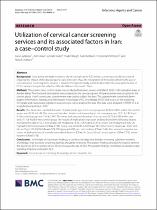| dc.contributor.author | Dadipoor, Sara | |
| dc.contributor.author | Alav, Azin | |
| dc.contributor.author | Kader, Zeinab | |
| dc.contributor.author | Kakhak, Hadi Eshaghi Sani | |
| dc.contributor.author | Mohseni, Shokrollah | |
| dc.contributor.author | Shahabi, Nahid | |
| dc.date.accessioned | 2023-04-13T11:28:45Z | |
| dc.date.available | 2023-04-13T11:28:45Z | |
| dc.date.issued | 2023 | |
| dc.identifier.citation | Dadipoor, S., Alavi, A., Kader, Z., Eshaghi Sani Kakhaki, H., Mohseni, S., & Shahabi, N. (2023). Utilization of cervical cancer screening services and its associated factors in iran: A case–control study. Infectious Agents and Cancer, 18(1) doi:10.1186/s13027-023-00496-w | en_US |
| dc.identifier.uri | https://doi.org/10.1186/s13027-023-00496-w | |
| dc.identifier.uri | http://hdl.handle.net/10566/8783 | |
| dc.description.abstract | Background Considering the high incidence rate of cervical cancer (CC) in Iran, screening is an efective way of
reducing the impact of the disease due to early detection. Thus, the recognition of the factors afecting the use of
cervical cancer screening (CCS) services is essential.The present study aimed to determine the associated factors of
CCS in women living in the suburbs of Bandar Abbas in the south of Iran.
Methods The present case–control study was conducted between January and March 2022 in the suburban areas of
Bandar abbas. Two hundred participants were assigned to the case group and 400 participants were assigned to the
control group. A self-constructed questionnaire was used to collect the data. This questionnaire contained demographic information, reproductive information, knowledge of CC, knowledge of CCS and access to the screening.
Univariate and multivariate regression analyses were run to analyze the data. The data were analyzed in STATA 14.2 at
a signifcance level of p<0.05.
Results The mean and standard deviation of participants’ age in the case group was 30.33±4.892, and in the control
group was 31.35±6.149. The mean and standard deviation of knowledge in the case group was 10.21±1.815 and
in the control group was 7.24±2.447. The mean and standard deviation of access was 43.72±6.339 in the case
and 37.17±4.828 in the control group. The results of multivariate regression analysis showed the following factors
increased the odds of CCS: knowledge (OR medium=18.697, OR high=13.413), access (OR medium=4.028, OR
high=8.126), being married (OR=3.193), being educated (OR diploma=2.587, OR university degree=1.432), middle and high SES (OR Middle=6.078, OR Upper=6.608), and not smoking (OR=1.144). Also, women’s reproductive
status, including history of sexually transmitted diseases (OR=2.612), use of oral contraceptives (OR=1.579), sexual
hygiene (OR=8.718).
Conclusions In the light of the present fndings, it can be concluded that besides increasing suburban women’s
knowledge, their access to screening facilities should be improved. The present fndings showed the need to remove
the barriers to CCS in women of low SES to increase the rate of CCS. The present fndings contribute to a better understanding of factors involved in CCS. | en_US |
| dc.language.iso | en | en_US |
| dc.publisher | BMC | en_US |
| dc.subject | Iran | en_US |
| dc.subject | Suburbs | en_US |
| dc.subject | Access | en_US |
| dc.subject | Knowledge | en_US |
| dc.subject | Cervical cancer screening | en_US |
| dc.title | Utilization of cervical cancer screening services and its associated factors in Iran: a case–control study | en_US |
| dc.type | Article | en_US |

